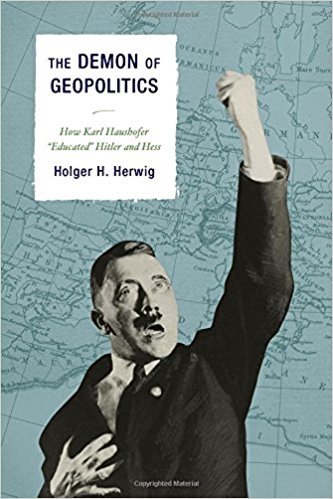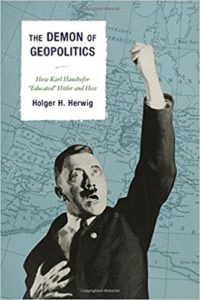
The Demon of Geopolitics: How Karl Haushofer “Educated” Hitler and Hess by Holger H. Herwig
 Karl Haushofer, the man who popularized the term Lebensraum (living space), has been accused of many misdeeds. In 1945, US Chief of Counsel, Sidney S. Alderman, writing for Justice Robert H. Jackson at Nuremberg, wrote that “Haushofer was Hitler’s intellectual godfather. It was Haushofer, rather than Hess, who wrote Mein Kampf…” (xi). More recently, a biographer, Bruno Hipler, insisted that Haushofer was “Hitler’s master teacher” and “the father of Nazi ideology” (xii). Others, such as the CBS and NBC anchor Roger Mudd, have claimed patent untruths: that Haushofer established the Thule Society, an important völkisch precursor to the NSDAP in Munich; that he created the Schutzstaffel, Himmler’s feared SS; and that he was the architect of Hitler’s extermination policies. Others have insisted that Haushofer was the father or even the lover of Rudolf Hess, Hitler’s deputy Führer until May 1941.
Karl Haushofer, the man who popularized the term Lebensraum (living space), has been accused of many misdeeds. In 1945, US Chief of Counsel, Sidney S. Alderman, writing for Justice Robert H. Jackson at Nuremberg, wrote that “Haushofer was Hitler’s intellectual godfather. It was Haushofer, rather than Hess, who wrote Mein Kampf…” (xi). More recently, a biographer, Bruno Hipler, insisted that Haushofer was “Hitler’s master teacher” and “the father of Nazi ideology” (xii). Others, such as the CBS and NBC anchor Roger Mudd, have claimed patent untruths: that Haushofer established the Thule Society, an important völkisch precursor to the NSDAP in Munich; that he created the Schutzstaffel, Himmler’s feared SS; and that he was the architect of Hitler’s extermination policies. Others have insisted that Haushofer was the father or even the lover of Rudolf Hess, Hitler’s deputy Führer until May 1941.
The truth is more complicated than exaggerated taglines. In The Demon of Geopolitics, Holger Herwig, professor of history emeritus at the University of Calgary, sets out to demystify Haushofer’s biography. Despite the sensationalist title—Haushofer educated Hess, but he spent relatively little time with Hitler—this is a sober account of an arch-conservative whose life and views sat uncomfortably with the Nazis. Haushofer, for example, remained fiercely loyal to his beloved wife, Martha, despite her Jewish lineage. Similarly, as a staunch admirer of the Japanese, Haushofer did not view the world through the same racist lenses as the Nazis. Still, he unleashed a torrent of geopolitical writings that gave the Nazis ideological ballast. These and other incongruities keep Haushofer’s life—and Herwig’s book—from being just another biography about another odious Nazi.
Born in 1869, Haushofer was the son of Max Haushofer, a professor of economics and statistics at the Royal Polytechnical University in Munich. Max was not only a professor, but also the author of the poetic-trilogy Der ewige Jude (The Eternal Jew), a fact mentioned but not analyzed by Herwig. Karl entered the Bavarian army in 1887 and the War Academy in 1895. Following graduation, he took up an officer posting with the Bavarian General Staff.
In 1908, the General Staff sent Haushofer on an extended study trip to Japan. There, Haushofer was mesmerized by the school curriculum of history, ethics, gymnastics, and visits to warrior sites that nourished a military ethos within society. He came to believe that this civil-military relationship created the perfect harmony of people, nature, and state necessary for Japan’s greatness. On his and Martha’s return, Haushofer wrote Dai Nihon (1913), “Great Japan,” a tract intended (in his words) to “direct Central Europe’s gaze to the strengthening and rejuvenation that Japan owes to the storm of steel [generated by] its wars” (17). To Haushofer, war was “the last great test of a nation’s right to exist,” it was a “struggle for elbow room,” and it was the “ultimate arbiter” of relations between states (100). Not only had the Japanese proven themselves in war, defeating China and Russia, but they had also annexed Korea, thereby securing Lebensraum. Haushofer always defended the Japanese people, despite Pan-German and later Nazi questioning of the “yellow” race.
During World War I, Haushofer distinguished himself as a military commander on both the eastern and western fronts. Yet he spent much time contemplating the political aspects of war. He came to the conclusion that Germany should have been allied with Russia and Japan, as “three great peoples of the future” who could break the “stranglehold of the Anglo-Saxons” (49). For Haushofer, America, with its soulless materialist and capitalist ethos, was the great enemy standing in Germany’s way. Haushofer now came to analyze the world in grander terms: in one letter he expressed his joy at “hav[ing] the feeling [that I am] truly one of those who can think in continents, who can have a sense for global spaces” (49). Continents and global spaces now became Haushofer’s obsessions. At his grandest, Haushofer sketched out a Pan-Eurasian bloc—Europe, Asia, and Africa, led by Germany—that would be impervious to Anglo-Saxon encroachments.
With Germany’s defeat, Haushofer fled into academia. On the strength of his writings on the Far East, he was made an associate professor (Honorarprofessor) at the University of Munich. He now worked on developing the discipline of geopolitics (Geopolitik). Drawing on the works of Friedrich Ratzel and Rudolf Kjellén, he insisted that states were not static entities, bound by a given geography. Instead, they were living organisms that grew or contracted, depending on how they wielded “spatial dynamics of power” (126). For Haushofer, geopolitics demanded an all-encompassing, interdisciplinary analysis that fit the discipline’s dynamic subject matter. It was to draw on a wide variety of fields including biology, geography, history, law, and zoology. For all the grandiosity of his vision, Haushofer actually had difficulty defining his discipline. One of his clearer definitions ran as follows: “Geopolitics is the science of the earth relationships of political processes. It is based on the broad foundations of geography, especially on political geography, which is the science of the political organisms in space and their structure. Moreover, geopolitics sets out to furnish the tools for political actions and the directives for political life as a whole. Thus geopolitics becomes an art; namely, the art of guiding practical politics. Geopolitics is the geographic science of the state” (123). The reader might well wonder: Was geopolitics a science? An art? A political agenda?
In 1919, Haushofer met Rudolf Hess, an eager university student, and took him under his wing. The two men developed an intense teacher-student relationship, based on their common war experiences and postwar political views. By then, Haushofer had become a convinced anti-Semite. He believed that the Versailles Treaty should be overturned. He dreamed of a new Caesar who would return Germany to an idealized Wilhelmine glory. Immersing himself in the right-wing political scene in Munich, Haushofer followed Hess in joining Epp’s Free Corps Oberland. Through Hess, he also met Hitler. After the Beer Hall Putsch, Haushofer visited Hess—and thereby Hitler—in Landsberg Prison. During summer and fall 1924, the Munich professor spent many Wednesdays holding seminar-style conversations with the two inmates. Hitler later claimed that “Landsberg was my university [education] at state expense” (xiv).
The time that Haushofer spent with Hitler was quite limited—perhaps twenty-two hours in all. Despite Alderman’s allegations, not a shred of evidence suggests that Haushofer wrote Mein Kampf. But did Haushofer influence its contents? Elements of Haushofer’s world view, including the emphasis on the regenerative aspects of war, present in Dai Nihon (that Hitler read in Landsberg), was evident in Mein Kampf. So, too, was much of Haushofer’s language. The term Lebensraum, introduced to Hitler via Hess and Haushofer, first entered the Nazi lexicon in Mein Kampf. Hitler also used other geopolitical notions such as “territorial formation,” “borders of accident,” “constriction of Lebensraum,” “relationship of population to territoriality” and “corrective and educational military training”(103). Still, much of what was found in Mein Kampf was simply a reflection of the nineteenth-century social Darwinism that Hitler and Haushofer shared. Moreover, Haushofer never explicitly outlined how his geopolitics—with all its potential criminality—could concretely be applied to Germany.
Back in Munich, Haushofer tirelessly promoted geopolitics. Over the next decades, he published literally hundreds of books and articles. Beyond his university lectures, he was a frequent radio commentator. He spoke on behalf of many right-wing organizations, particularly those devoted to upholding the interests of Germans now living beyond German borders. He built new institutions to propagate his work. He co-founded the German Academy, modeled on the Alliance Française; it was to popularize all things German beyond Germany’s borders. Haushofer also co-founded the Journal of Geopolitics (Zeitschrift für Geopolitik), a major journal dedicated to spreading his ideas.
Hitler’s coming to power should have enhanced Haushofer’s influence. But just the opposite was true. After 1933, Haushofer was bedeviled by his wife’s Jewish origins. He constantly worried about Martha and their two children, Albrecht and Heinz. Despite pressure, Haushofer refused to divorce his wife. He repeatedly turned to Hess to secure exceptions to the regime’s anti-Semitic legislation for his family. He was gradually pushed out or withdrew from the organizations that he had built up. Still, he brokered a diplomatic agreement with Japan and played a role in the 1938 Munich Conference. With the 1939 Nazi-Soviet Non-Aggression Pact, it appeared that Hitler was forging the German-Russian-Italian-Japanese transcontinental Eurasian block that Haushofer had long advocated. Soon, however, it was clear that Haushofer’s doctrine was merely Hitler’s temporary expedient.
In May 1941, Hess took his ill-fated flight to broker a German-British peace. Haushofer, who met with Hess several times in spring 1941, likely encouraged this mission; he believed that Germany should seek Lebensraum through global, not continental, expansion. Once his protector was a British captive, Haushofer had to tread even more lightly in Nazi circles. His son Albrecht, a budding geopolitician, nonetheless worked for the Foreign Office in Berlin. Albrecht was eventually implicated in the July 1944 assassination attempt against Hitler. Both father and son were arrested in summer 1944; Karl was released in late August. Albrecht, however, was executed by the regime in the last days of April 1945. At war’s end, Karl Haushofer was arrested and interrogated by the Americans. Released, he returned to his Bavarian country house. Unable to accept Albrecht’s death, he and Martha committed joint suicide by taking poison in March 1946—an unexpected end to the zealous exponent of a globally expansive Lebensraum.
Although Herwig occasionally refers to works published in the 1960s and 1970s as “recent,” this is a solid biography, carefully researched and free of major errors or omissions. Herwig dully concludes, however, that “Haushofer helped to legitimize Hitler’s claim to power and his expansionist foreign policy” (218). He then quotes another biographer, Hans-Adolf Jacobsen, who wrote of Haushofer: “History…will hardly be able to declare him innocent of this moral complicity” (218). But does Haushofer deserve more damning judgement? An anti-Semite in love with his Jewish wife. A passionate advocate of geopolitics unable to define his discipline. An inspiration to a murderous regime that executed his son. Unable to think through and resolve the paradoxes of his lived experience, Haushofer was more than just morally complicit in the Nazi regime. His failure of thought makes him, and others like him, responsible for enabling the Third Reich.
Reviewed by Catherine Epstein,
The Demon of Geopolitics: How Karl Haushofer “Educated” Hitler and Hess
by Holger H. Herwig
Publisher: Rowman & Littlefield
Hardcover / 292 pages / 2016
ISBN: 978-1442261136
Published on September 6, 2017.




